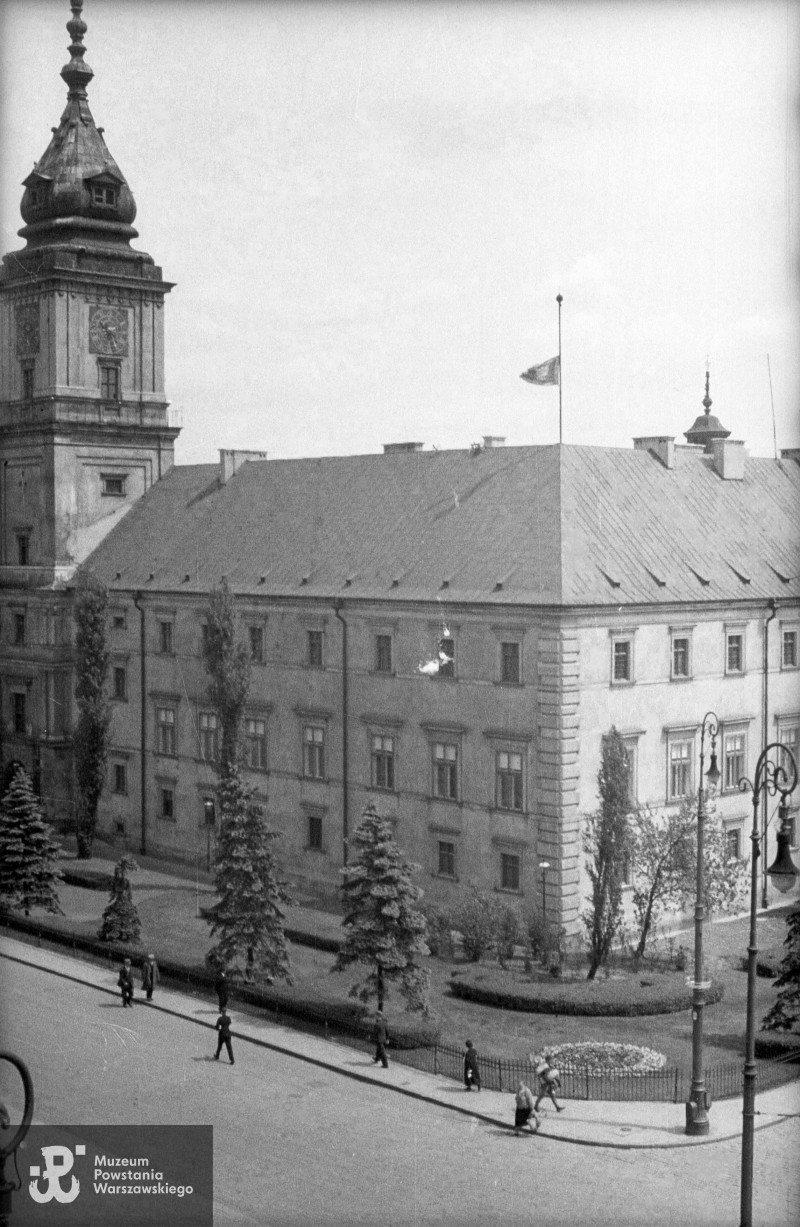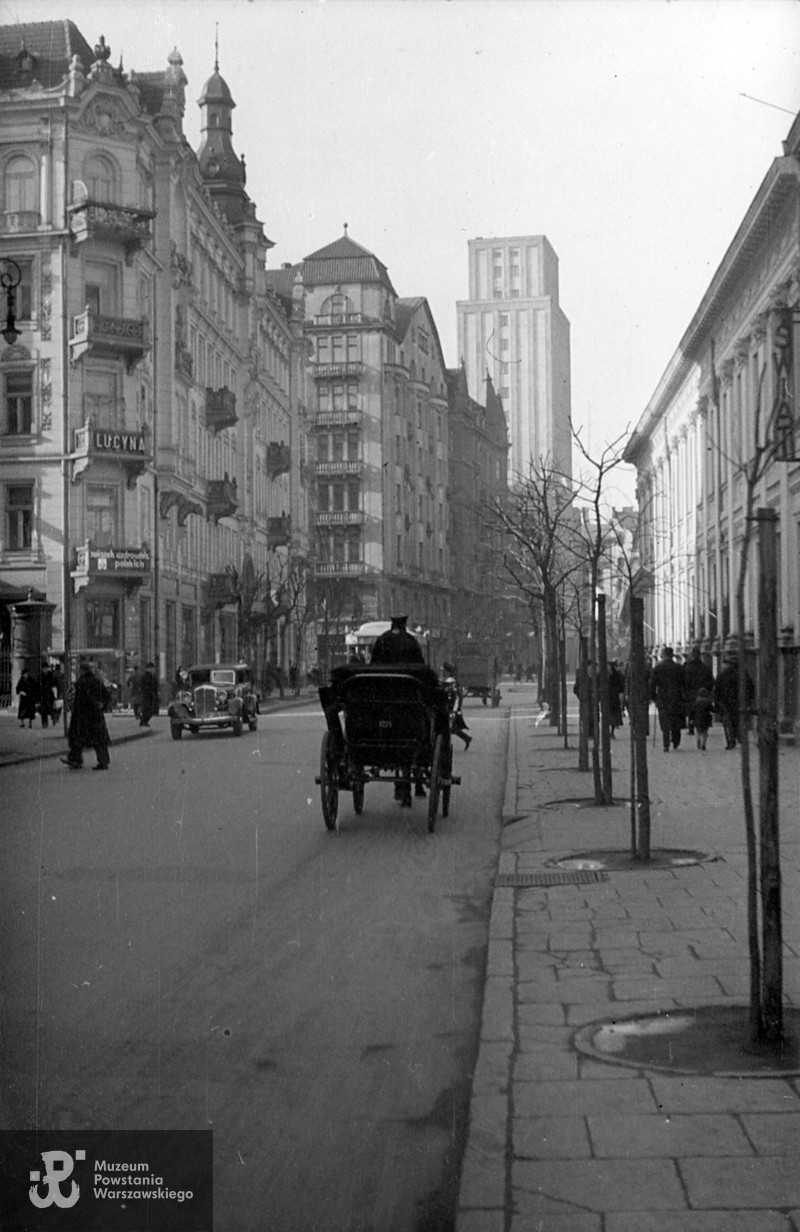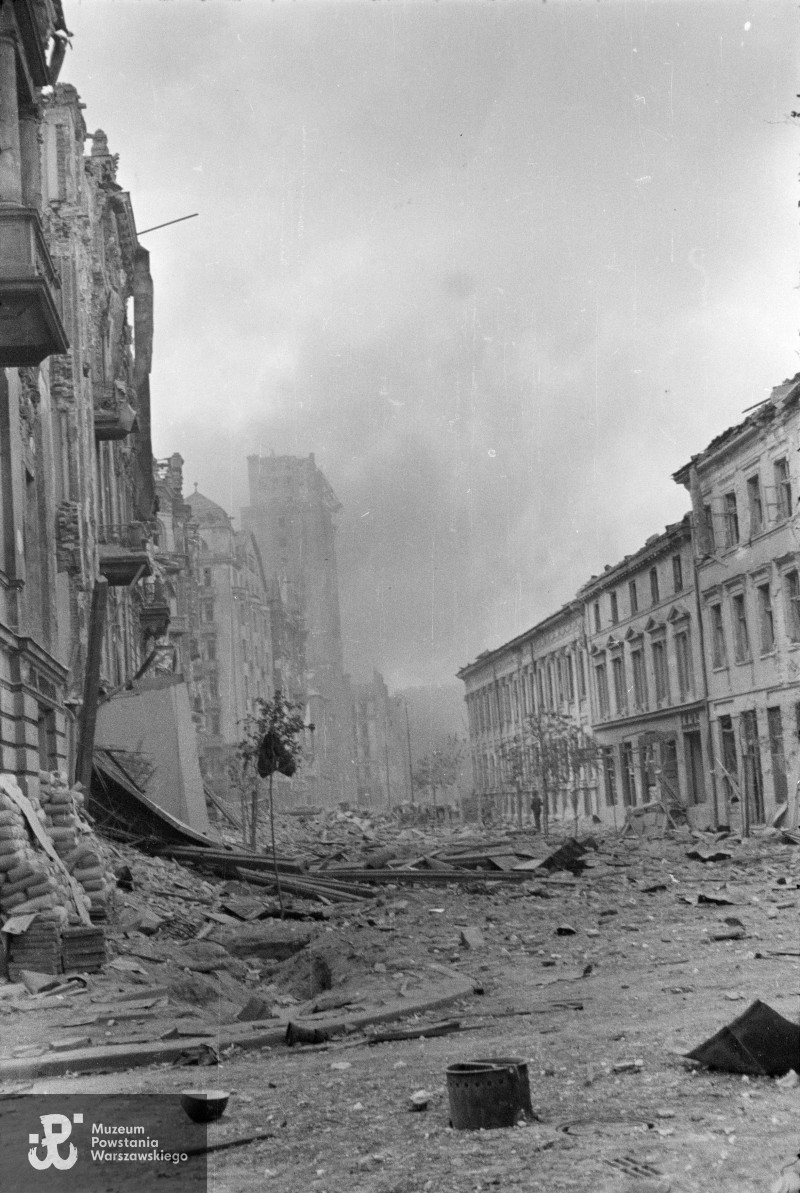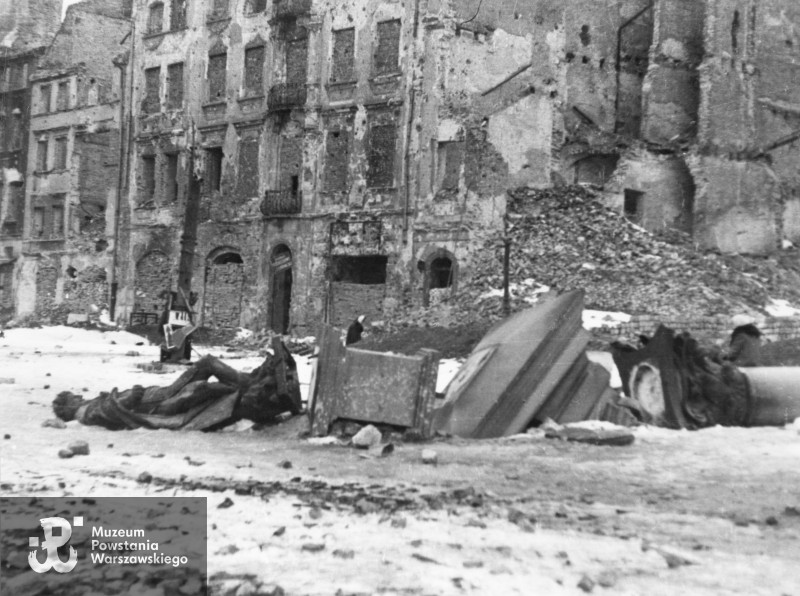



A city with chaotic and inconherent architecture, that is how Warsaw is often perceived by tourists. For Varsovians however, their city is beautiful because it was brought back to life. We cannot boast about ideally preserved relics of the past but thanks to thousands of Warsaw’s inhabitants the city has risen from the ashes.

Royal Castle in Warsaw, 1935. Photo: Witold Edward Koneczny/Warsaw Rising Museum Digital Collection
Warsaw started to flourish in the late 16th century when king of Poland Sigismund III Vasa chose Warsaw as his residential city. Gradually since 1596 government institutions were being moved from Cracow and the king moved into the Royal Castle for good after Smoleńsk campaign in 1611. When Warsaw was under Russia rule in the times of partitions of Poland, the city would not develop as fast. Obviously, Warsaw was not in the scope of interest for Russian tzars. Nonetheless, the governors of Warsaw turned the city into a modern one, therefore when Poland regained freedom in 1918, the city, though facing many challenges, was not backward at all.

King Sigismund III Column, 1935. Photo: Witold Edward Koneczny/Warsaw Rising Museum Digital Collection
One mayor of the city is particularly well-remembered, namely Sokrat Starynkiewicz. Under his governance between 1875-1892 Warsaw changed its face because the water-sewage system was built as well as Bródno Cemetery, Gas Plant in Wola, not to mention such projects as newly paved streets, street lighting and horse tramways. In those times Warsaw had 500,000 inhabitants who lived in a quite restricted area. As late as in 1916 new districts were added, namely Ochota, Żoliborz, Targówek, Saska Kępa and Mokotów. After 1918 and especially after 1934 a new project to modernize Warsaw was drawn by Stefan Starzyński.
In 1939 Warsaw had more than 1,3 mln inhabitants. In the interwar period (between 1918-1939) Warsaw saw many investments: Okęcie airport, railway tunnel under city centre (kolej średnicowa), new residential districts, 30 new schools, National Museum, “Dom Turysty” Hotel, Market Hall in Żoliborz, Służewiec Racetrack. New facilities were added to Przemienienie Pańskie Hospital in Praga; the Sejm House was opened as well as the seat of State’s Railways and the highest skyscraper - Prudential. New plans were drawn to develop Warsaw, namely the Piłsudski Bridge or a 25 km tube.
The day WW2 started in Warsaw there were 20 theatres and 70 cinemas, many restaurants and hotels. The World’s Fair was planned to take place in 1940. Projects of exhibition halls that were to be build where National Stadium stands nowadays had been prepared for this purpose before. What is more, there were also plans to organize Olympic Games in 1948 or 1952, therefore plans were drawn to build Olympics centre in Siekierki.
All plans were ruined by the war that started in 1939 and the first bombardments that caused damage. The photograph that depicts the Royal Castle in flames turned out to be iconic for Poland.
During WW2 Warsaw was gradually being detroyed. In the September campaign in 1939 10 percent of the city was demolished. Then, in June 1941 when the Third Reich attacked Soviet Union there were some carpet bombings that again brought losses in life and material substance of the city. In May 1943 the destruction of Warsaw reached unprecedented levels when the Warsaw Ghetto was torn down to foundations. The next stage of a strategic anihilation of the city took place after the end of the Warsaw Rising. It has to be noted that a two month urban battle led to substantial destruction especially in the districts of the Old Town, Northern part of the City Centre, Powiśle and Wola. After the Rising when the insurgents and civilians were deported from the city, German Vernichtungskomanndo units launched their plan to anihilate what was still standing. In fall and winter 1944/1945 many quarters of the city were burned down, one by one. Destructon fury lasted till the Red Army entered the city in mid January 1945. The estimates say that 30 percent of the architectural substance of the left river bank districts in Warsaw were destroyed then.

Szpitalna Street, Prudential skyscraper, 1935. Photo: Witold Edward Koneczny/Warsaw Rising Museum Digital Collection

Szpitalna Street covered in rubble after bombardment in September 1944. Photo: Eugeniusz Lokajski “Brok”/Warsaw Rising Museum Digital Collection
If we add to that the losses we endured in the Warsaw Rising, September Campaign in 1939 and the Warsaw Ghetto Uprising, it turns out that military operations destroyed 85% of Warsaw. The photographs taken at the beginning of 1945 are truly apocalyptic.
Warsaw was almost totally deserted after the Rising. Only a few thousand “Warsaw Robinsons” would hide in the ruins. Gradually, the inhabitants who were previously expelled would return only to discover their property in ruin. There was no electricity, no tap water when they returned. All the bridges had been blown up. 90 percent of industrial facilities, 90 percent of historical buildings, 70 percent of apartments, 70 percent schools, 95 percent cultural institutions and all the railway stations practically ceased to exist, not to mention the whole infrastructure, when it comes to railways and tramways.
It has to be underlined that the plan to destroy the capital of Poland was a common feeling among German leadership from the very beginning of WW2. Warsaw had been considered the heart of Polish resistance movement and Poles belived it to be their cultural, artistic and political centre, therefore Germans decided that Warsaw needed to be degraded to become a provincial town.
The urban project by Hubert Gross and Otto Nurnberg from 6 February 1940, known as the Pabst’s Plan (Pabst was the Chief Architect of Warsaw in WW2), aimed at turning Warsaw into a new German town of Warsaw (German: Die Neue Stadt Warschau). Only 130,000 inhabitans were to be allowed to live in Warsaw. The left river bank districts were to be destined solely for Germans, whereas the right river bank of the Vistula river would have given shelter to a small district only for Poles who were to be working for Germans. The new Warsaw was to be located to the south and south-west of the Old Town, which was to be preserved as a relic of the ‘supposedly’ German heritage of Warsaw.
In 1942 the project was modified. Most of Warsaw was to be demolished and turned into a provincial town that would become a housing centre for German elite (Ostgruppe) of 40,000 people who were to be in charge of the territories that had been conquered in the East. According to the modified project, the Old Town had to be destroyed and the Royal Castle turned into Parteivolkshalle (People’s Hall). Today it is difficult to assess the scope and details of urban projects the Germans had drawn for Warsaw. The Third Reich was defeated on the eastern front, therefore the Pabst’s Plan was not implemented. That is why, the outburst of the Warsaw Rising was ‘a great chance’ for Nazi leaders “to solve the Polish problem”.
During Nurnberg trials, SS-Obergruppenführer Erich von dem Bach-Zelewski, who was the commander of German forces at the time of the Warsaw Rising, admitted that he had received the order:
“Every inhabitant must be killed, no prisoners are allowed, Warsaw is to be razed to the ground and in this way an intimidating example for the whole of Europe is to be created.”
in: Sawicki, J “Zburzenie Warszawy. Zeznania generałów niemieckich przed polskim prokuratorem członkiem polskiej delegacji przy Międzynarodowym Trybunale Wojennym w Norymberdze”, (The Destruction of Warsaw. The testimony of German generals laid down before a Polish prosecutor, a member of the Polish delegation at the International War Tribunal in Nurnberg), Warsaw 1949
Systematic destruction followed. Particularily tragical and symbolic were the acts of barbarity against the objects of historical value, namely the destruction of the King Sigismund Column, the Tomb to the Unknown Soldier and blowing up of the Royal Castle. Right after the fall of the Old Town the following institutions were burned down: the Zamoyski Library, Main Archive, the Central Archives of Historical Records and Treasury Archive, just to name a few.

The ruins of buildings at the Castle Square in Warsaw, 1945. Photo: Olgierd Budrewicz/Warsaw Rising Museum Digital Collection
Ludwig Fischer, the head of the Warsaw District declared on 11 October 1944:
“Warsaw has to be torn down to foundations. I mean it has to be razed to the ground even when we are still at war as long as any military objectives related to Festung Warschau* (*note: fortifying Warsaw in the anticipation of the Red Army’s attack) are not on the way. All materials, textiles and furniture have to be secured before a target is pulled down. The operation is within civil administration’s prerogative. I make it official bacause the new order related to annihilation of Warsaw that was issued by Fuhrer is of great importance when it comes to new politics towards Poland.”
in: Sawicki, J “Zburzenie Warszawy. Zeznania generałów niemieckich przed polskim prokuratorem członkiem polskiej delegacji przy Międzynarodowym Trybunale Wojennym w Norymberdze” (The Destruction of Warsaw. The testimony of German generals laid down before a Polish prosecutor, a member of the Polish delegation at the International War Tribunal in Nurnberg), Warsaw 1949.

The ruins of the Old Town. Destroyed Column of King Sigismund III, 1945. Photo: Eugeniusz Haneman/ Warsaw Rising Museum Digital Collection
The houses, factories and institutions were emptied. Anything that presented any value was looted and then the buildings were set on fire. As a consequence, out of 957 buildings that were registered as monuments, 782 were totally destroyed and 141 partially demolished. It means that only 34 monuments survived in a fairly good condition. Due to heroism of the Polish librarians, the Warsaw University Library was spared from the damage. Also, many collections of the Natonal Museum were saved by the employees of the Museum who together with Stanisław Lorenz, the Director of the Museum, pretended they were busy accomplishing the conservation work.
However, taking all the losses into account, chances to rebuild the Polish capital were minimal. There were plans to move the capital city to Łódź where many institutions had already operated since the beginning of 1945. Among the alternatives, Cracow was considered to become again the capital city of Poland and Warsaw ruins to be turned into ‘a national monument’ and the new city founded somewhere towards the south near Góra Kalwaria. The reconstruction of Warsaw was a 100 percent political decision that was made in Moscow.
“On 3 January 1945, thus before Red Army took over Warsaw, the communist temporary Lublin government decided to rebuild Warsaw and turn it again into capital city. Its members were fully aware that moving the capital city somewhere else would have a negative political resonance.”
In: Waingertner P. “Czwarta stolica. Kiedy Łódź rządziła Polską (1945-1949) (The fourth capital. When Łódź ruled Poland”, Łódź 2019
Before the Conference in Jalta, Stalin needed support for his politics. Therefore, the vision of Poland that is reborn with capital city in Warsaw served the purpose perfectly well. What is more, after 17 January 1945 the inhabitants of Warsaw would return to the city. They walked over frozen Vistula to the ruins of their homes and struggled to reconstruct them. Life was brought back to the city even before the authorities said ‘yes’. As early as on 22 January 1945 the Office for the Organization of the Reconstruction of Warsaw was established and when the National Council passed on the resolution to rebuild Warsaw on 3 February 1945, the Office changed its name to the Warsaw Reconstruction Office (BOS) that operated since 14 February under this name. It is important to note that the first post war mayor of the city, Marian Spychalski, was an architect. The unprecedented project was coordinated by a group of eminent prewar architects: Jan Zachwatowicz, Roman Piotrowski, Józef Sigalin, Witold Plapis, to name a few. All of them, no matter of their political views, were united with one aim in mind – rebuilding Warsaw.
Later, Stanisław Jankowski joined the team. He was one of ‘the Silent and Unseen’ and a soldier who took part in the Warsaw Rising 1944. (https://www.1944.pl/artykul/artysci-w-powstaniu-warszawskim-stanislaw-jan,5103.html).
One of the first challenges they faced was marking previously chosen buildings with red boards: “Warsaw Reconstruction Office – A monument of national heritage. Any interference strictly forbidden.” These boards played an important role in spreading the news that monuments needed to be protected. In May the National Museum opened an exhibition “Warsaw accuses” where the losses the city endured were presented in detail.
The establishment of the Office launched one of the most ambitious projects when it comes to city planning. Never before anyone tried to rebuild a city after such an apocalypse. Sceptics would literally translate the name of the BOS Office into “Boże Odbuduj Stolicę” (Lord, please Rebuild our Capital City), which proved how unreal the task was. Furthermore, the decision proposed by Jan Zachwatowicz to faithfully rebuild the city was against the communist doctrine at the time.
Western European countries that also faced the challenges to rebuild their cities would choose the option to rebuild only key monuments. We may observe that when visiting Germany, Great Britain, Holland, France or Italy. The arguments set forth by Zachwatowicz were deeply patriotic. He believed that nation and monuments are one. All through the years the Office had two leading groups: the Zachwatowicz team known as “zabytkarze” (the monuments aficionados) and the Piotrowski & Sigalin team: “modernizatorzy” (the modernisers). The division reflected their political afiliations as those gathered around Zachwatowicz were closely attached to the Home Army (Armia Krajowa), whereas Piotrowski and Sigalin represented the interests of the postwar communist government.
Zachwatowicz had a dream to reconstruct prewar Warsaw, which was possible thanks to the documents that were prepared once WW2 started. Already then they anticipated the afterwar reconstruction. Though the area to fully reconstruct the Old Town changed a lot on the way, Jan Zachwatowicz’s determination led to substantial reconstruction of the Old Town and the Royal Route (Trakt Królewski).
The work proposed by the Warsaw Recontruction Office according to projects and schedules was unbelievably fast: both the Poniatowski and railway bridges were opened in 1946 and on 22 July 1949 King Sigismund Column was erected. At the same time the road under the Old Town (known as ‘trasa W-Z’) was opened together with a new residential district in Mariensztat and the first houses in the Old Town. In 1950 Staszic Palace was recontructed and the construction of the Marszałkowska residential district (MDM) was launched.
This extraoridinary effort to reconstruct the city was recognized by UNESCO and in 1980 the Old Town of Warsaw was inscribed on the UNESCO World Heritage List. The site is the very first monument on the List that was reconstructed in its whole. The UNESCO decision was a tribute to Polish architects, conservator-restorerers, historians and art historians who faced and accomplished an unprecedented challenge in the history of humankind.
Interestingly enough, The Office used many ideas that had been proposed before WW2 in a project that was awarded at the Paris Exposition des Arts et Techniques dans la Vie Moderne in 1937.
In order to find financial resources to rebuild Warsaw a special fund was opened in 1948, namely the Social Fund for the Reconstruction of Warsaw (SFOS/ Społeczny Fundusz Odbudowy Stolicy). It was a special tax - every Polish employee was taxed with 0,5 percent of their monthly salary. Additionally, some products and tickets for cultural events were taxed and fund-raisers organized. That is why almost half of the financial and material resources the Polish People’s Republic had would go to reconstruction of Warsaw: Wilanów Palace, Łazienki Palace, Staszic Palace and Nowy Świat Street, Kazimierzowski Palace, Królikarnia Palace, Great Theatre and many statues including those commemorating Copernicus, Mickiewicz, Chopin, Poniatowski or the King Sigismund III. In 1958 the resources that were gathered in the fund were send to other locations: Radogoszcz Museum in Łódź, old town in Gdańsk and Poznań, Wawel Castle, Szczecin, Sandomierz, Kazimierz Dolny and Lublin. In 1966 the fund was transformed into a Social Fund for New Schools due to the anniversary of 1,000 years of the Polish State because 1,000 schools were planned to be built then.
Warsaw Reconstruction Office was closed down in September 1950 and its work was to be continued by the institutions under the Mayor of the City as well as those of central administration. However, the projects that were prepared by the Office were finished at the beginning of the 1960s. The last symbolic stage was the reconstruction of the Royal Castle.
Author: Karolina Wolska-Pabian, PhD